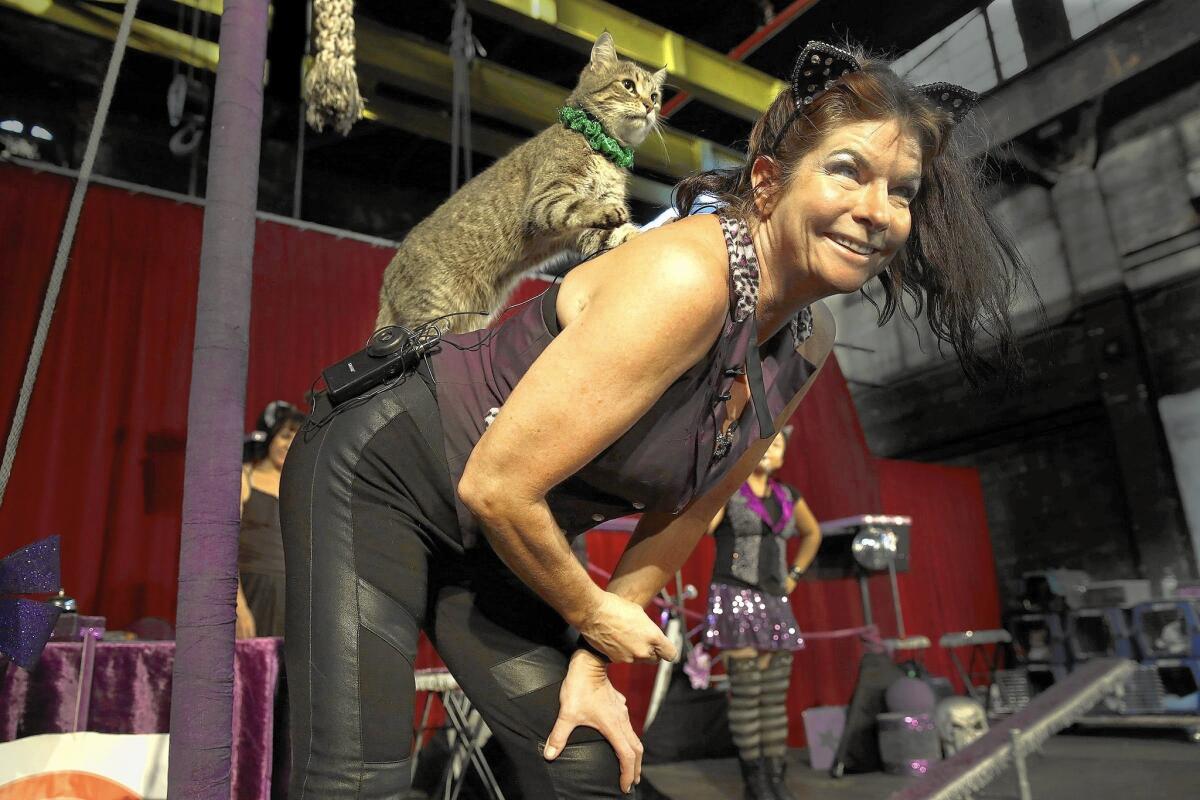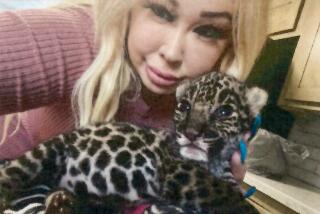Putting on a circus with 14 felines? It’s as easy as herding cats

- Share via
Reporting from NEW YORK — Samantha Martin was anxious, and it wasn’t because she was living in a bus with 14 cats, two white rats, a groundhog and a chicken named Cluck Norris. That’s normal for her.
She was anxious because she had just three hours to prepare the felines, the fowl and the rodents for their first performance in New York City before a sellout crowd.
It was opening night at the circus. The Acro-Cats circus. As in cats jumping through hoops. Cats walking on high wires. Cats balancing atop balls. Cats riding skateboards, bowling, strumming guitars and pounding keyboards.
You might be asking: Can cats really be trained to do those things?
“You can train your cat to do everything these cats can do,” said Martin, who formed the Acro-Cats in 2006. “Or not do.”
They are, after all, cats.
“Cats tend to get distracted,” Martin said.
As she spoke inside the Acro-Cats bus, the occupants stirred to life after an afternoon snooze. The cats, who have their own space in the rear, began clawing the scratching posts and leaping among the cat trees. A blizzard of gray, orange, black and white filled the air. Paws skimmed the top of Martin’s head, and tails swished in her face.
Cats raced up and down the 35-foot-long bus. They leapt onto the bedding lining the sides and sank their claws into its softness. A puffy gray cat sat silently atop a kitty litter container, watching with the wide-eyed yet bored expression only a cat can muster. The chicken, rats and groundhog kept to themselves in their travel carriers. So did a handful of diva cats, who do not play well with others.
Martin got into the cat circus business the usual way: Her rat circus didn’t pan out.
She had dreamed of becoming an animal trainer and was charmed by rats when, as a girl growing up in Illinois, she saw the 1970s rat-centric movies “Willard” and “Ben.”
“I just thought, wow, that’s the most awesome thing ever,” said Martin, who perfected her rat-training techniques while in college. Her big break came while she was working at a pet store in the Chicago area. Two men came in, looking for a rat trainer for a movie they were filming. Martin quit her job and took on the role. She doesn’t know if the movie was made, but the gig persuaded her to start the Acro-Rats circus.
From there, things snowballed. Local media reported on the woman who trained rats. Geraldo Rivera interviewed her. She was flown to Italy to put on an Acro-Rats show. “When Samantha rats her hair, she doesn’t even need a comb,” a Chicago Tribune headline said in a 1989 story on the Acro-Rats.
“But rat movies are few and far between,” Martin said. She needed a more appealing creature to draw crowds and to train for movies, TV and advertising.
That’s about the time a white cat with sea-green eyes named Tuna came into her life. Tuna responded to Martin’s training clicker and treats, quickly learning to swat at things on cue and to ring a bell with her paw.
A salmon-loving star was born.
Martin began working with other cats, all rescued from shelters or the streets, and she catered the circus to each cat’s talents and temperament.
Alley is a jumper, leaping between platforms and officially recognized by the Guinness World Records book as making the longest jump by a cat — 6 feet. An orange-and-white cat named Buffy walks across the stage atop a ball. Buffy’s sister Sookie pushes a tiny shopping cart.
Others perform high-wire acts, crawl up and down poles and swat at signboards for audiences who sigh “Awwwwww” each time a cat saunters on stage or loses interest in the show and wanders into the crowd.
The New York premiere in July was the first of several shows, all sold out, at an event space in Brooklyn.
The bus, with a large cat face painted on its front, was parked outside the warehouse where the circus would take place. A white cat named Dakota sat on the dashboard looking out at a street lined with auto shops and weedy lots. Occasionally, a stray cat meandered past.
Large fans whirred as the Acro-Cats’ publicist, Polly Smith, and assistant trainer Seunga Park prepared the stage with platforms, sparkly hoops and other props.
Once the doors opened, the crowd quickly filled all 200 or so seats. Martin, wearing form-fitting black pants and a vest, cat ears on her head, and shimmer to bring out her cat-like, blue-green eyes, took the stage.
There were some hiccups. Tuna, whose job includes turning pages of a signboard, instead sharpened her claws on the rug and sniffed the floor. After a few clicks and words of encouragement, Tuna swatted the signboard to display the “applause” sign.
The audience cheered.
A blue-eyed, light gray cat named Nue exited her carrier on cue but jumped off the stage.
“Awwww,” the audience crooned.
Oz hesitated before poking his paw through tissue paper lining the inside of a hoop and jumping through.
The audience cheered.
“Pretty impressive, considering we’ve only been working on that for nine years,” Martin said.
A cat scampered up a pole, then came back down and landed expertly atop Martin’s back. Another jumped onto a purple ball and rolled it across the stage. There was a cat spinning a pinwheel, and three cats weaving among and atop one another as they walked back and forth along a row of saucer-sized, elevated platforms placed side by side.
The show ended with the Rock Cats, a feline quartet accompanied by Cluck Norris pecking a tambourine and cymbal with her beak, and Garfield the groundhog using his teeth to bring down a baton onto a gong.
As with many bands, there was tension. The keyboardist tried to swat the guitarist. The drummer rubbed against the guitar and ignored her drum sticks.
The band’s sound, achieved by luring the cats to motion with bits of salmon and chicken, could best be described as raw. Tuna was on the cowbell.
Martin interspersed mini-lectures on cat care and cat adoption throughout the show. She noted that all her cats are trained to run into their carriers when she whistles, something that could save a pet if a situation required quick evacuation. She said people don’t realize cats can be taught to socialize if humans spend time with them.
“That’s one of the things I want to do with the show: teach people to develop better relationships with their cats,” said Martin, who believes the popularity of cat videos online is erasing the image of feline fans as lonely women in shabby bathrobes.
“I think we’re coming out of the cat closet,” she said, noting that most of her audiences have as many men as women.
Martin does not sugarcoat the challenges of running the Acro-Cats show. She spends several months at a time on the road and rarely sees her Chicago apartment. Before New York, they performed in Philadelphia. Next spring, the circus will be on the West Coast. By then, Martin hopes to have replaced the 1963 bus, which she bought with $30,000 raised on Kickstarter.
Martin dreams of an RV with expandable sides. More room, she said, for the cats.
Twitter: @tinasusman
ALSO:
Why the Border Patrol has launched an effort to recruit female agents
Three killed when two planes collide near San Diego’s Brown Field
University of Texas delays removal of Jefferson Davis statue
More to Read
Sign up for Essential California
The most important California stories and recommendations in your inbox every morning.
You may occasionally receive promotional content from the Los Angeles Times.











